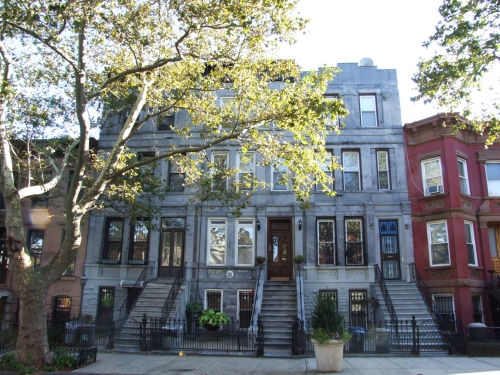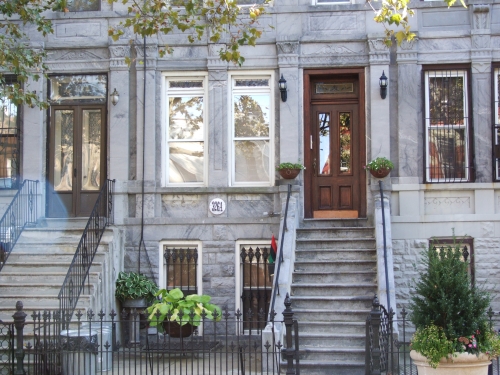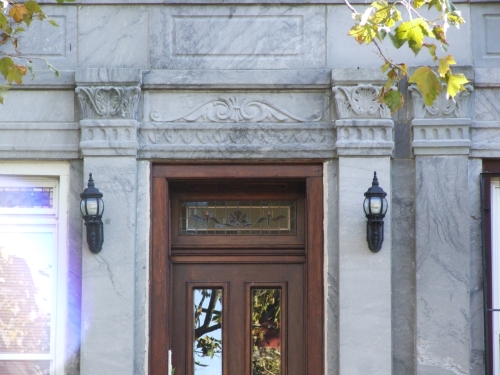Building of the Day: 326-328 Decatur Street
Brooklyn, one building at a time. Name: Row houses Address: 326-328 Decatur Street Cross Streets: Stuyvesant Avenue and Malcolm X Boulevard Neighborhood: Stuyvesant Heights Year Built: 1886 Architectural Style: Renaissance Revival Architect: John C. Bushfield Other Work by Architect: Three other groups of houses on Decatur Street Landmarked: Yes, part of the new Bedford Stuyvesant/Expanded…

Brooklyn, one building at a time.
Name: Row houses
Address: 326-328 Decatur Street
Cross Streets: Stuyvesant Avenue and Malcolm X Boulevard
Neighborhood: Stuyvesant Heights
Year Built: 1886
Architectural Style: Renaissance Revival
Architect: John C. Bushfield
Other Work by Architect: Three other groups of houses on Decatur Street
Landmarked: Yes, part of the new Bedford Stuyvesant/Expanded Stuyvesant Heights HD (2013)
The story: Brooklyn’s row house facades are generally made up of only four different building materials: wood, brownstone, limestone or brick. Within those four materials comes a wealth of combinations, colors, surfaces and quality. Except for some of the wood framed houses, row houses, no matter what’s on top, are solidly brick underneath. If you think about it, it’s really rather amazing to see the variety of housing styles, colors, and shapes that can made from just these elements, in many cases augmented by terra cotta, pressed metal and wooden ornament and trim. Of course, there are always exceptions.
I’m sure that when our Brooklyn neighborhoods were being developed, more than one architect or developer thought of cladding row houses in marble. After all, marble is a time honored building material, and is quite durable, and easily cut into slabs or panels, even more so after the late 1870s, when the pneumatic drill was invented. There were marble quarries available to New York builders, so why don’t we see more marble clad row houses?
The obvious answer had to be expense. Marble is the choice for large, important civic buildings, as well as the mansions of the über-rich for a reason, it cost a lot. Much of the marble used in New York came from quarries in Vermont, and perhaps the marble on these houses did, as well. But one would think that the houses of the rich, both in Manhattan and in Brooklyn, would still have more examples of marble cladding. There must be other reasons it was just not popular.
I’ve been wondering who designed these houses for years, but was never able to find the architect. It’s interesting that it turned out to be a man who was basically a cypher in Brooklyn’s architectural world. Perhaps it takes an unknown maverick to buck the trends and try something new. John C. Bushfield trained as a roofer, and was listed as a builder in Brooklyn business guides in the 1880s. As far as we’ve discovered so far, he designed four groups of row houses, all on Decatur Street, beginning with two groups at the beginning of the street, near Throop Avenue. His other houses are interesting, but this group is the most memorable.
The three houses are squeezed into a fifty foot lot, making each a bit shy of 17 feet wide. The numbering is 326, 326A, and 328 Decatur. They are four story brownstones rising up from the surrounding three story houses, and would be eye catching for that reason alone. But as you walk by, what catches the eye is the material. “Is that marble??” I’ve heard any number of people say that in walking tours, or just strolls down this block. Yes, it is. These are the only marble clad row houses that I’ve ever seen.
Design-wise, they are Renaissance Revival houses, built before the style was hugely popular, with rough cut marble stone on the basement levels, and smooth, nicely veined marble above. There are some very restrained classical style pilasters with acanthus leaf capitals, carved scroll pediments, and incised wave motif, among other features. Bushfield may not have had the training of a more established architect, but he had good instincts, and didn’t glop up the houses with a lot of distracting design elements, and let the marble speak for itself. Subtle color touches in the use of stained glass transoms, plus the owner’s plantings add some needed color. Too bad someone removed the cornice on 328, the biggest change to the group.
So why aren’t there more of these around? Perhaps people thought they looked too much like mausoleums or tombstones. Or perhaps it was just economics. We’ll never know. But I’m glad we have these three houses on our Bedford Stuyvesant streetscape — another reason why this area was just designated a historic district. We can’t afford to lose architectural gems like these. GMAP








What's Your Take? Leave a Comment